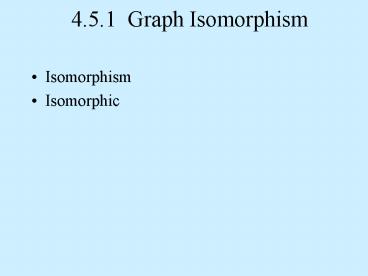4'5'1 Graph Isomorphism - PowerPoint PPT Presentation
1 / 20
Title:
4'5'1 Graph Isomorphism
Description:
... Isomorphism. Isomorphism. Isomorphic. 4.5.2-4 Planar ... Graph G: V=9, E=16, F=9, V-E F=9-16 9=2. Graph H: V=9, E=17, F=10, ... Proof: For every natural F ... – PowerPoint PPT presentation
Number of Views:79
Avg rating:3.0/5.0
Title: 4'5'1 Graph Isomorphism
1
4.5.1 Graph Isomorphism
- Isomorphism
- Isomorphic
2
4.5.2-4 Planar Graphs
- Planar graph, planar representation, face
- Euler's Theorem
- Girth, edge-vertex inequality
3
Theorem 4.5.1 Euler's Theorem
- For a planar connected graph
- V-EF 2
- Prove by induction on F .
4
Example 4.5.4 Euler's Theorem
Figure 4, Page 219 Graph G V9, E16,
F9, V-EF9-1692 Graph H V9, E17,
F10, V-EF9-17102 Graph I V9,
E8, F1, V-EF9-812
5
Theorem 4.5.1 Euler's Theorem
Proof For every natural F define the statement
statement F every planar connected graph
with F faces, V vertices, and E edges satisfies
V-EF2. A graph with a cycle has at least two
faces one inside and one outside. Therefore a
connected graph with just one face has no cycle,
and is a tree, having exactly one more vertex
than edge V-E1. This implies that
(V-E)F112, so statement 1 is true.
6
Theorem 4.5.1 Euler's Theorem
Now choose any natural number F for which
statement F is true, and let G' be any planar
connected graph with F'F1 faces, V' vertices,
and E' edges. Since G' has at least two faces,
G' has a cycle. Remove one edge from that cycle,
joining two faces and giving a subgraph G with F
faces, V vertices, and E edges, where VV' and
E1E'. Therefore V' - E' F' V -
(E1) (F1) V - E F 2 and
statement F1 is a consequence of statement F.
Since F was arbitrary, then by the principle of
mathematical induction statement F is true for
every F.
7
Start Lesson 21aQ20--
8
Definition 4.5.4 Girth
The girth g of a connected graph is the number of
edges in its shortest cycle.
9
Proof of Theorem 4.5.2
10
Concluded Proof of Theorem 4.5.2
11
Theorem 4.5.2 Edge-Vertex Inequality
This is an upper bound for the number of edges.
12
Example 4.5.5
Therefore the graph is NOT planar.
13
A
14
K5
15
B
16
K3,3
17
P
18
End Lesson 21a
19
(No Transcript)
20
MATHEMATICAL SYMBOLS
- ? ? ? ? ? ? ? ? ?
- ? ? ? ? ? ?
- ? ? ? ? ? ? ? ?
- ? ? ? ? ?

